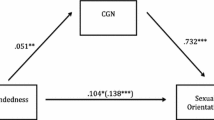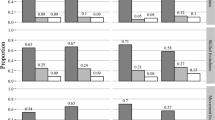Abstract
Human asexuality is defined as a lack of sexual attraction to anyone or anything and it has been suggested that it may be best conceptualized as a sexual orientation. Non-right-handedness, fraternal birth order, and finger length ratio (2D:4D) are early neurodevelopmental markers associated with sexual orientation. We conducted an Internet study investigating the relationship between self-identification as asexual, handedness, number of older siblings, and self-measured finger-lengths in comparison to individuals of other sexual orientation groups. A total of 325 asexuals (60 men and 265 women; M age, 24.8 years), 690 heterosexuals (190 men and 500 women; M age, 23.5 years), and 268 non-heterosexuals (homosexual and bisexual; 64 men and 204 women; M age, 29.0 years) completed online questionnaires. Asexual men and women were 2.4 and 2.5 times, respectively, more likely to be non-right-handed than their heterosexual counterparts and there were significant differences between sexual orientation groups in number of older brothers and older sisters, and this depended on handedness. Asexual and non-heterosexual men were more likely to be later-born than heterosexual men, and asexual women were more likely to be earlier-born than non-heterosexual women. We found no significant differences between sexual orientation groups on measurements of 2D:4D ratio. This is one of the first studies to test and provide preliminary empirical support for an underlying neurodevelopmental basis to account for the lack of sexual attraction characteristic of asexuality.






Similar content being viewed by others
Notes
Identical analyses performed on all ethnicities in this sample revealed a similar pattern of results.
References
20/20. (2006). Abstinence forever [video clip]. Available from http://www.youtube.com/watch?v=CeKGOMUVU7g&feature=PlayList&p=FD6E45790348DC2F&playnext=1&playnext_from=PL&index=30.
American Psychiatric Association. (2000). Diagnostic and statistical manual of mental disorders (4th ed., text rev.) Washington, DC: Author.
Berenbaum, S. A. (2002). Prenatal androgens and sexual differentiation of behavior. In E. A. Eugster & O. H. Pescovitz (Eds.), Developmental endocrinology: From research to clinical practice (pp. 293–311). Totowa, NJ: Humana Press.
Blanchard, R. (1997). Birth order and sibling sex ratio in homosexual versus heterosexual males and females. Annual Review of Sex Research, 8, 27–67.
Blanchard, R. (2004). Quantitative and theoretical analyses of the relation between older brothers and homosexuality in men. Journal of Theoretical Biology, 230, 173–187.
Blanchard, R. (2008). Review and theory of handedness, birth order, and homosexuality in men. Laterality, 13, 51–70.
Blanchard, R., & Bogaert, A. F. (1996). Homosexuality in men and number of older brothers. American Journal of Psychiatry, 153, 27–31.
Blanchard, R., Cantor, J. M., Bogaert, A. F., Breedlove, S. M., & Ellis, L. (2006). Interaction of fraternal birth order and handedness in the development of male homosexuality. Hormones and Behavior, 49, 405–414.
Blanchard, R., Kolla, N. J., Cantor, J. M., Klassen, P. E., Dickey, R., Kuban, M. E., & Blak, T. (2007). IQ, handedness, and pedophilia in adult male patients stratified by referral source. Sexual Abuse: A Journal of Research and Treatment, 19, 285–309.
Blanchard, R., & Lippa, R. (2007). Birth order, sibling sex ratio, handedness, and sexual orientation of male and female participants in a BBC Internet research project. Archives of Sexual Behavior, 36, 163–176.
Blanchard, R., Zucker, K. J., Siegelman, M., Dickey, R., & Klassen, P. (1998). The relation of birth order to sexual orientation in men and women. Journal of Social Science, 30, 511–519.
Bogaert, A. F. (1997). Birth order and sexual orientation in women. Behavioral Neuroscience, 111, 1395–1397.
Bogaert, A. F. (1998). Physical development and sexual orientation in women: Height, weight, and age of puberty comparisons. Personality and Individual Differences, 24, 115–121.
Bogaert, A. F. (2001). Handedness, criminality, and sexual offending. Neuropsychologia, 39, 465–469.
Bogaert, A. F. (2003). Interaction of older brothers and sex-typing in the prediction of sexual orientation in men. Archives of Sexual Behavior, 32, 129–134.
Bogaert, A. F. (2004). Asexuality: Prevalence and associated factors in a national probability sample. Journal of Sex Research, 41, 279–287.
Bogaert, A. F. (2006a). Biological versus nonbiological older brothers and men’s sexual orientation. Proceedings of the National Academy of Sciences of the United States of America, 103, 10771–10774.
Bogaert, A. F. (2006b). Toward a conceptual understanding of asexuality. Review of General Psychology, 10, 241–250.
Bogaert, A. F. (2007). Extreme right-handedness, older brothers, and sexual orientation in men. Neuropsychology, 21, 141–148.
Bogaert, A. F. (2012). Understanding asexuality. Plymouth, UK: Rowman & Littlefield Publishers.
Bogaert, A. F., & Blanchard, R. (1996). Physical development and sexual orientation in men: Height, weight and age of puberty differences. Personality and Individual Differences, 21, 77–84.
Bogaert, A. F., Blanchard, R., & Crosthwait, L. E. (2007). Interaction of birth order, handedness, and sexual orientation in the Kinsey interview data. Behavioral Neuroscience, 121, 845–853.
Brotto, L., Knudson, G., Inskip, J., Rhodes, K., & Erskine, Y. (2010). Asexuality: A mixed-methods approach. Archives of Sexual Behavior, 39, 599–618.
Brotto, L. A., & Yule, M. A. (2011). Physiological and subjective sexual arousal in self-identified asexual women. Archives of Sexual Behavior, 40, 699–712.
Camperio-Ciani, A., Corna, F., & Capiluppi, C. (2004). Evidence for maternally inherited factors favouring male homosexuality and promoting female fecundity. Proceedings of the Royal Society of London B, 271, 2217–2221.
Cantor, J. M. (2012). Is homosexuality a paraphilia? The evidence for and against. Archives of Sexual Behavior, 41, 237–247.
Cantor, J. M., Blanchard, R., Christensen, B. K., Dickey, R., Klassen, P. E., Beckstead, A. L., et al. (2004). Intelligence, memory, and handedness in pedophilia. Neuropsychology, 18, 3–14.
Cantor, J. M., Klassen, P. E., Dickey, R., Christensen, B. K., Kuban, M. E., Blak, T., et al. (2005). Handedness in pedophilia and hebephilia. Archives of Sexual Behavior, 34, 447–459.
Caswell, N., & Manning, J. T. (2009). A comparison of finger 2D:4D by self-report direct measurement and experimenter measurement from photocopy: Methodological issues. Archives of Sexual Behavior, 38, 143–148.
Chivers, M. L., Rieger, G., Latty, E., & Bailey, J. M. (2004). A sex difference in the specificity of sexual arousal. Psychological Science, 15, 736–744.
Chivers, M. L., Seto, M. C., & Blanchard, R. (2007). Gender and sexual orientation differences in sexual response to sexual activities versus gender of actors in sexual films. Journal of Personality and Social Psychology, 93, 1108–1121.
Chivers, M. L., Seto, M. C., Lalumière, M. L., Laan, E., & Grimbos, T. (2010). Agreement of self-reported and genital measures of sexual arousal in men and women: A meta-analysis. Archives of Sexual Behaviour, 39, 5–56.
Corballis, M. C. (1991). The lopsided ape: Evolution of the generative mind. New York: Oxford University Press.
CNN Showbiz Tonight. (2006). A look at asexuality [video clip]. Available from http://www.youtube.com/watch?v=kkoo1lUp3ns.
Ellis, L., & Ames, M. A. (1987). Neurohormonal functioning and sexual orientation: A theory of homosexuality–heterosexuality. Psychological Bulletin, 101, 233–258.
Ellis, L., & Blanchard, R. (2001). Birth order, sibling sex ratio, and maternal miscarriages in homosexual and heterosexual men and women. Personality and Individual Differences, 30, 543–552.
Fox News Dayside. (2006). Sex-free romance [video clip]. Available from http://www.youtube.com/watch?v=lmXXgRvotGM.
Geschwind, D. H., Miller, B. L., DeCarli, C., & Carmelli, D. (2002). Heritability of lobar brain volumes in twins supports genetic models of cerebral laterality and handedness. Proceedings of the National Academy of Sciences of the United States of America, 99, 3176–3181.
Gordon, A. (2002). SurveyMonkey.com-web-based survey and evaluation system. The Internet and Higher Education, 5, 83–87.
Gosling, S. D., Vazire, S., Srivastava, S., & John, O. P. (2004). Should we trust web-based studies? A comparative analysis of six preconceptions about Internet questionnaires. American Psychologist, 59, 93–104.
Green, R. (2000). Birth order and ratio of brothers to sisters in transsexuals. Psychological Medicine, 30, 789–795.
Grimbos, T., Dawood, K., Buriss, R. P., Zucker, K. J., & Puts, D. A. (2010). Sexual orientation and the second to fourth finger length ratio: A meta-analysis in men and women. Behavioral Neuroscience, 124, 278–287.
Hare, L., Bernard, P., Sánchez, F. J., Baird, P. N., Vilain, E., Kennedy, T., & Harley, V. R. (2009). Androgen receptor repeat length polymorphism associated with male-to-female transsexualism. Biological Psychiatry, 65, 93–96.
Jay, D. (2008). Asexuality visibility and education network. Retrieved from http://www.asexuality.org/home/overview.html.
Klar, A. J. S. (2003). Human handedness and scalp hair-whorl direction development from a common genetic mechanism. Genetics, 165, 269–276.
Lalumière, M. L., Blanchard, R., & Zucker, K. J. (2000). Sexual orientation and handedness in men and women: A meta-analysis. Psychological Bulletin, 126, 575–592.
Lippa, R. A. (2003a). Are 2D:4D finger-length ratios related to sexual orientation? Yes for men, no for women. Journal of Personality and Social Psychology, 85, 179–188.
Lippa, R. A. (2003b). Handedness, sexual orientation, and gender-related personality traits in men and women. Archives of Sexual Behavior, 32, 103–114.
Manning, J. T. (2002). Digit ratio: A pointer to fertility, behavior and health. New Brunswick, NJ: Rutgers University Press.
Manning, J. T., Churchill, A. J. G., & Peters, M. (2007). The effects of sex, ethnicity, and sexual orientation on self-measured digit ratio (2D:4D). Archives of Sexual Behavior, 36, 223–233.
Manning, J. T., Scutt, D., Wilson, J., & Lewis-Jones, D. I. (1998). The ratio of 2nd to 4th digit length: A predictor of sperm numbers and concentrations of testosterone, luteinizing hormone and oestrogen. Human Reproduction, 13, 3000–3004.
McFadden, D. (2002). Masculinization effects in the auditory system. Archives of Sexual Behavior, 31, 99–111.
McFadden, D., Loehlin, J. C., Breedlove, S. M., Lippa, R. A., Manning, J. T., & Rahman, Q. (2005). A reanalysis of five studies on sexual orientation and the relative length of the 2nd and 4th fingers (the 2D:4D ratio). Archives of Sexual Behavior, 34, 341–356.
Medland, S. E., Duffy, D., Spurdle, A., Wright, M., Geffen, G., Montgomery, G., & Martin, N. (2005). Opposite effects of androgen receptor CAG repeat length on increased risk of left-handedness in males and females. Behavior Genetics, 35, 735–744.
Montel Williams Show. (2007). Asexuality [video clip]. Available from http://www.youtube.com/watch?v=rTD-nnUzTME.
Mustanski, B. S., Bailey, J. M., & Kaspar, S. (2002a). Dermatoglyphics, handedness, sex, and sexual orientation. Archives of Sexual Behavior, 31, 113–122.
Mustanski, B. S., Chivers, M. L., & Bailey, J. M. (2002b). A critical review of recent biological research on human sexual orientation. Annual Review of Sex Research, 13, 89–140.
Oldfield, R. C. (1971). The assessment and analysis of handedness: The Edinburgh inventory. Neuropsychologia, 9, 97–113.
Pagan Westfall, S. (2004). Glad to be A. New Scientist, 184, 40–43.
Poston, D. L., & Baumle, A. K. (2010). Patterns of asexuality in the United States. Demographic Research, 23, 509–530.
Prause, N., & Graham, C. A. (2007). Asexuality: Classification and characterization. Archives of Sexual Behavior, 36, 341–356.
Rahman, Q., & Wilson, G. D. (2003). Born gay? The psychobiology of human sexual orientation. Personality and Individual Differences, 34, 1337–1382.
Reimers, S. (2007). The BBC Internet study: General methodology. Archives of Sexual Behavior, 36, 147–161.
Rife, D. C. (1940). Handedness, with special reference to twins. Genetics, 25, 178–186.
Rothblum, E. D., & Brehony, K. A. (1993). Boston marriages: Romantic but asexual relationships among contemporary lesbians. Amherst: University of Massachusetts Press.
Seddon, B. M., & McManus, I. C. (1991). The inheritance of left-handedness: A meta-analysis. Unpublished manuscript.
Seto, M. C. (2012). Is pedophilia a sexual orientation? Archives of Sexual Behavior, 41, 231–236.
Snabes, M. C., & Simes, S. M. (2009). Approved hormonal treatments for HSDD: An unmet medical need. Journal of Sexual Medicine, 6, 1846–1849.
Storms, M. D. (1980). Theories of sexual orientation. Journal of Personality and Social Psychology, 38, 783–792.
The View. (2006). Secrets of asexuals [video clip]. Available from http://www.youtube.com/watch?v=6kPfLYuQlL8.
Tucker Carlson. (2006). Under the radar-asexuality [video clip]. Available from http://www.youtube.com/watch?v=Iwxo6t7XBYs.
Williams, T. J., Pepitone, M. E., Christensen, S. E., Cooke, B. M., Huberman, A. D., Breedlove, N. J., et al. (2000). Finger-length ratios and sexual orientation. Nature, 404, 455–456.
Acknowledgments
Funding for this study was from a University of British Columbia Hampton Research Grant awarded to L.A.B. M.A.Y. was funded by a Predoctoral Fellowship. We wish to thank Martin L. Lalumière for his generous statistical assistance.
Author information
Authors and Affiliations
Corresponding author
Rights and permissions
About this article
Cite this article
Yule, M.A., Brotto, L.A. & Gorzalka, B.B. Biological Markers of Asexuality: Handedness, Birth Order, and Finger Length Ratios in Self-identified Asexual Men and Women. Arch Sex Behav 43, 299–310 (2014). https://doi.org/10.1007/s10508-013-0175-0
Received:
Revised:
Accepted:
Published:
Issue Date:
DOI: https://doi.org/10.1007/s10508-013-0175-0




